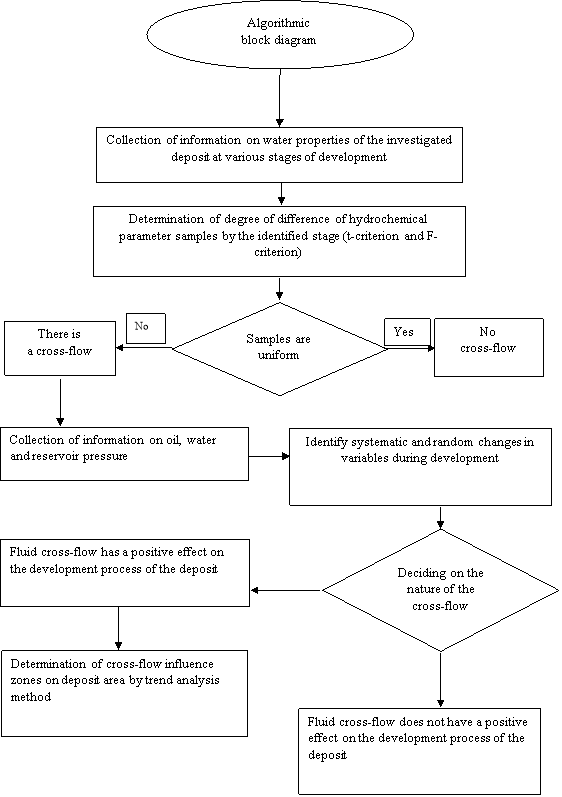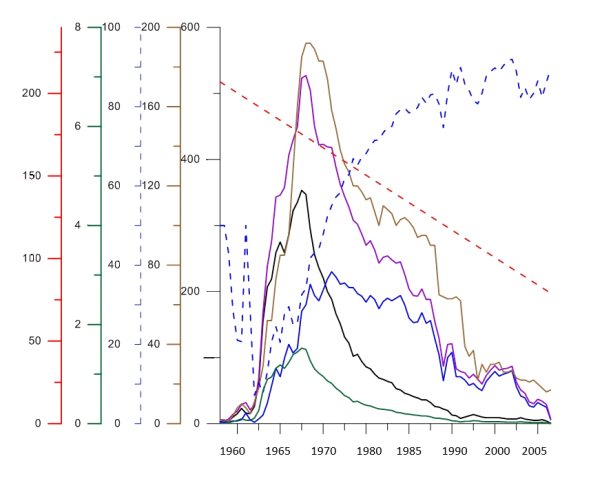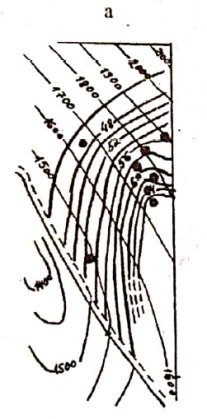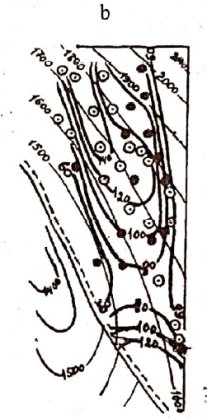Based on the analysis of hydrodynamic parameters and geological and mining information, the article studies the manifestation of interlayer hydrocarbon cross-flows, proposes a method, and uses a mathematical apparatus (parametric criteria and trend analysis). make it possible to make a judgment on the violation of hydrodynamic insulation of layers during the development of a multilayer field, on the scale of this manifestation and its impact on the hydrodynamic parameters of the field. Physical and chemical properties of the formation and injected water, well rates, and reservoir pressure were used as data carriers. It has been proven that when noticeable changes are detected, the liquid cross-flows from other layers with higher pressure.
Keywords: cross-flows between layers, water injection, trend analysis, parametric tests, dynamics oil recovery, changes formation pressure in the exploration process.
One of the most widely used methods in field development is water injection. 80 % of the volume of oil produced falls on facilities that are covered by water injection. As is known, the efficiency of the water injection process at different sites is manifested in different ways.
The reasons for the low effect of the water injection process are different, one of which is inter-bed fluid cross-flow, which leads to the redistribution of fluids throughout the reservoir. The fluid cross-flow process is unregulated. This complicates the water injection process, which adversely affects the overall development performance of the facilities, and may even lead to the need for a major overhaul of the entire development system.
Hydrodynamic isolation of the targets may be compromised during the development of multi-zone fields. As a result of this, the liquid cross-flows from one stratigraphic complex to another, thereby the redistribution of fluids throughout the field as a whole can significantly change. Under certain conditions, this phenomenon may play a positive role in the development of reservoirs. In all cases, regardless of what changes may occur as a result of the cross-flow, this phenomenon must be studied, and the scale of its manifestation is investigated. These studies are particularly relevant when reservoirs are developed with water injection.
Studies have shown that liquid cross-flows between formations are possible in the presence of thin shales separating objects operated at different intensities and thus with different differences in formation pressures; the conducting nature of disjunctive disorders; operation of wells with poor-quality plugging or their use with simultaneous development of two or more objects with common filters.
Our studies show that relying only on geological and field methods is insufficient when studying the phenomenon and nature of the fluid cross-flow. Therefore, it is advisable to solve the problem by combining traditional (geological and field study) and mathematical methods, i.e. by analyzing the manifestation of informative features of each multi-zone field target in time using mathematical methods. As a methodological approach, it is proposed to use an area trend analysis, which allows not only to establish the regularities of changes in the informative parameters of formation water by area but also to identify local zones within the same area.
As a result, the obtained data on the distribution of water injected into the formation by traditional and mathematical methods are compared, which increases the accuracy of the obtained results. It should be noted that the informational content of the analyzed features should be scientifically justified.
Informative features. In developing a multi-strata field, especially with water injection, the physicochemical characteristics of formation water are the most informative. Systematic analyses performed in all oil and gas production departments make it possible to establish the characteristic features of the ion-salt composition of the water of the facilities, to determine the scale of their change both in terms of the area of the facilities and in the course of development. Deviations of ion-salt composition values from their systematic components make it possible to judge the violation of hydrodynamic isolation of formations. Such changes are especially clearly captured when non-stratified waters (marine, lake, river, and mixtures thereof) are injected into adjacent facilities.
Formation pressures and well rates are also subject to unusual changes in the event of a hydrodynamic system failure. Although these changes in the development of late-stage reservoirs occur on an insignificant scale, the nature of their manifestation gives reason to talk about the possibility of replenishing the reservoir energy due to the supply of liquid from other high-pressure formations. Therefore, systematic studies on the nature and degree of manifestation of these signs seem important when studying the phenomenon of cross-flow.
The information base of the study was 2914 analyses of waters taken from 1372 wells during different periods of oil recovery throughout the entire section. To solve the problem with the help of sulfates, as the most informative parameter characterizing the cross-flows, objects were selected, the waters of which are practically sulfate-free.
Mathematical methods of data analysis. To determine the degree of variability of the informative features of reservoirs during development, the most suitable are the Student, Fisher, and trend analysis parametric criteria with the identification of differences between variables and their systematic components [1,2]. If the use of the former answers whether the values of the analyzed features have changed significantly over time, the latter already determines the scale of these changes in the reservoir area.
Cross-flow diagram of the algorithm for the «Cross-flow» system solution of the assigned task is given in Fig. 1.

Fig. 1. Block diagram of the «Cross-flow» automated system
To represent the resolution of the proposed method, a hypothetical field is proposed as an example. The field is in the final stages of development. It is a typical brachyanticline. The fold is asymmetric: a gentler east wing and a steeper west wing. Development began in the 50s of the twentieth century. The following targets participate in the field with different degrees of productivity: A, B, C, D, E, F, G, H. Water injection is carried out at the last stage of development (1990). Water injection covers Targets E and F. It should also be noted that there are no shale units between these Targets and Target H. No artificial methods of exposure have been produced in the other above-mentioned facilities. The total volume of injected water into the E and F facilities is 40 million m 3 . In general, the water injection carried out on the two targets positively impacted the development of reservoir H.
For objects not covered by water injection, depending on their natural representation, the change in informative features should obey certain laws, expressed in a systematic decrease in oil production rates at different rates of water injection occurring with a decrease in reservoir pressure. The hydro-chemical parameters of these objects during development usually change monotonously, without being subject to sharp fluctuations. However, as the study of the geological and field materials of the reservoirs showed, the noted specific nature of the development of the reservoirs may be disturbed in some cases: significant changes are found in the manifestation of informative signs (the decrease in well production rates and formation pressures stops, the ion-salt composition changes sharply). Moreover, as the study of the field development materials showed, these changes are not observed everywhere but in local areas of the site area.
One of the marked local areas is located in the north-eastern part of reservoir E in Fig. 2. The facility has been under development here since 1964. In a zone with an area of about 46 hectares and throughout the area, oil production was carried out on a natural basis, mainly under a solution gas regime. For all the time in operation, 21 wells were transferred. Since the beginning of development, 450 thousand tons of oil and 2000 thousand/m 3 of water have been extracted from this section of the reservoir. As can be seen from Figure 2, from 1964 to 1968 with an increase in the number of production wells, annual oil production increased to 22 thousand tons. After this period, with almost the same number of wells, there is a systematic decrease in annual oil production to 2.4 thousand tons, accompanied by an increase in the water cut of the reservoir.

Fig. 2. Development Indicators of the North-East Flank of Reservoir H: Red-paste pressure (atm); Green — development rate (%); Blue — water cut (%); brown — well count; black oil, water (thousand tons)
Since 1994, the decline in production has been stopped. With a stable number of producing wells, there is stabilization and even some increase in oil production with a water cut of 93 %. Note that there is also a certain regularity in the change in formation pressures, i.e., first their sharp decrease, and then stabilization.
Analysis of the results of studying the hydro-chemical parameters of the facility at this site showed a sharp change in the ion-salt composition of the waters, expressed in an increase in the total mineralization of the waters on average from 45 to 103, chlorine ion from 14.2 to 47.2 mg-eq per 100 g of water. Other components of the produced water were subjected to appropriate changes. At the same time, it should be noted that sulfates are practically not contained in the waters taken from the deposit after 1990 (from traces to 0.6 mg/eq per 100 g of water).
Seawater with a significant content of sulfate ions (5.8–6.7 mg-eq per 100 g) was used as a working agent during water injection. This creates a real basis for the use of sulfate values in the sampled waters in determining the cross-flow directions in the water injection processes [3].
Significant changes in the informative features of the reservoir over time (before and after 1990) were established due to the use of Student and Fisher parametric criteria (in all cases t calculate >t tbl. and F calculate > F table , if α=0,05). A comparative analysis of water used as a working agent (seawater) and formation water indicates that a sharp change in the component composition of the water of Target E is associated with the cross-flow of liquid from other facilities where water injection is carried out. The analysis of the field material made it possible to show the possibility of a process from the overlying facilities E and F, into which, as shown above, more than 25 million m 3 of seawater was injected.
Following the algorithmic block diagram (Fig. 1), the determination of the influence (zone) of the cross-flow of liquid from the overlying horizons into reservoir H. Based on the values of the total salinity of the waters, a trend analysis was carried out.
For the period when there were no sulfates in the waters (until 1990), a II order trend map was built, taking into account the variability in total mineralization, which showed that the values of this parameter from northwest to southeast increased from 53.5 to 61 mg-Equiv. (Fig. 3.a).
To illustrate the variability of the variable overtime for the period 1990–2004, a trend map of order IV with a suitability factor of 89.9 (Fig. 3b) was compiled. Comparisons of these maps (Fig.3.a and 3. b) showed a widespread increase in the total mineralization values. This is especially pronounced in the northern and southern parts of the area, where injection wells and water injection areas are located. Here, the values reach 100–120 mg-eq per 100 g of water.
Analysis of constructed maps characterizing deviations of observed values of the studied variable from their trend components of IV order is of considerable interest. The deviation map («residue») is the isolines of the difference between the actual values of the total mineralization of waters H and their trend components of order IV. When considering, it can be seen that in addition to the observed pattern, the studied variable in the area undergoes other changes. The configuration of zero isolines identifies individual local zones with increased (positive) difference values (Fig. 3.c).




Fig. 3. Trend Maps for Total Salinity in Reservoir Waters of Reservoir H: a — the trend surface of the 2nd order before the cross-flow; b — 4th order trend surface after cross-flow; c-map of deviations («remainder») from the 4th order trend; 1- tectonic disturbance; 2 — isogypses along the roof H; 3- production wells as per H; 4- injection wells for horizons E and F; 5- trend isoline; 6- zero deviation line; 7-positive and negative deviation zones
The geological interpretation of the obtained results shows that fluctuations in the total mineralization of the object are obviously associated with the entry of highly mineralized water into the formation due to the cross-flow of overlying horizons. There is every reason to believe that the zone of influence of this process in time is constantly expanding. The extent of the spread of the effect of cross-flow, clearly identified by the use of trend analysis, is also confirmed by the results of the analysis of dynamic indicators of producing wells. So, well. X, located in the zones affected by cross-flow, oil rates and formation pressure not only stabilized but also showed a slight increase (Fig. 4).

Fig. 4. Development Parameters of Well X
Thus, based on the proposed method, it is possible to determine not only the phenomenon of fluid cross-flow between zones during the development of a multi-zone field but also the scale of its impact by area. The method can be used in the analysis of the development of multi-zone fields in the late stage of operation.
Thus, based on the above, the following conclusions can be drawn:
1) when detecting cross-flows from one developed horizon to another, it is necessary to pay attention primarily to the hydro-chemical variability of waters over time. For the conditions of the hypothetical field under investigation, the occurrence of sulfates in the sulfate-free waters of the oil reservoirs is a direct sign for solving the problem of interaction between the objects along the section;
2) when solving the issue of hydrodynamic isolation of stratigraphic complexes, observations of the average daily oil and water rates, formation pressure in the dynamics of wells, and in general for the studied horizon are important;
3) trend analysis, as a tool for establishing patterns of changes in mineralization by area, can correctly identify local zones corresponding to the location of the most intense cross-flows in certain areas of the developed deposit;
4) for production facilities G and H, where there is a relationship, it will be rational to proceed to their introduction.
5) it is desirable to use procedures for smoothing and extrapolating time series of production and their autocorrelation analysis when solving forecast problems of oil production dynamics in conditions of cross-flows.
References:
- Bagirov B. A. Geological Foundations of Further Development of Oil and Gas Fields. Baku: Elm, 1986. — 162 s.
- Bagirov B. A., Salmanov AM, Maharramov F. F., Akhundov E. T. On Fluid Cross-flows in Multi-Zone Fields. Proceedings of VNIGRI, 1988, p. 165–172.
- Mehdiyev S. F., Akhundov A. R., Voroshilov E. A. Practical issues of oil field hydrogeology. Publishing house «Elm», 1975.







